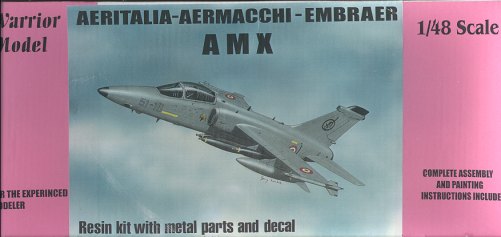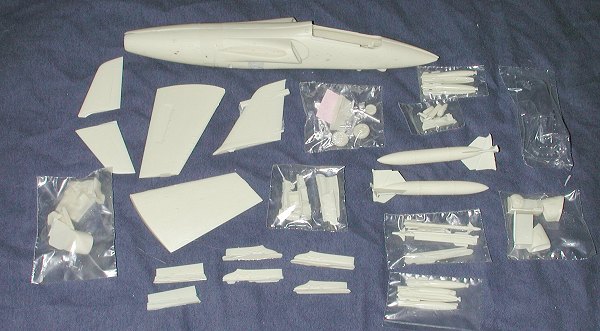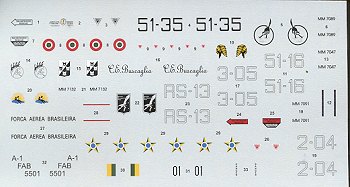
|
KIT: |
Warrior 1/48 AMX |
|
KIT # |
48010 |
|
PRICE: |
$ |
|
DECALS: |
6 options |
|
REVIEWER: |
|
|
NOTES: |
Resin multimedia kit |

|
HISTORY |
In Italy, AerItalia and AerMacchi came to an agreement on an upcoming design to be called the AMX. A few years later, in 1981, Embraer of Brazil joined in with the two Italian companies as the AMX was just what they were looking for to fulfill their attack aircraft requirements. An agreement for 187 Italian and 79 Brazilian aircraft was reached with the two Italian companies paying about 70% of the costs. As in all these multi-national aircraft builds, each company was responsible for certain sections of the aircraft, which were then sent to the appropriate locale for complete assembly.
Six prototypes were built, two of them being built and tested in Brazil. The first prototype, MM X594, first flew on May 15 1984 in Italy. Fifteen days later, it was lost due to a failure in the Rolls Royce engine. An additional prototype was built to replace it. By 1986, all Italian and Brazilian prototypes were flying and undergoing the usual rigorous testing. It was then decided that a two-seat trainer wouldn't be a bad idea and the contract was so modified to include this aircraft type, called the AMX-T
The AMX-T is a twin seater, high performance transonic turbofan jet, specifically developed for Advanced and Fighter Lead-In Training. It maintains the operational characteristics of the AMX - Ground Attack Fighter - already in operation with the Brazilian (FAB) and Italian (AMI) Air Forces. It is a high subsonic trainer with a low level dash speed in excess of 500 kt in any armed configuration. The AMX-T was selected by the Venezuelan Air Force (FAV) to replace the old and venerable T-2A Buckeyes in the advanced training phase.
AMX is a aircraft with shoulder-mounted wings, swept-back at 27.5°, with the engine air intakes placed in the top half of the fuselage, behind the cockpit. The pilot sits down in high position, offering a good view around the airplane. The tail is of traditional design, with the single fin and mobile elevators being similar to those of the Tornado. An in-flight refueling probe, equipped with a spotlight at the base of the probe, may be installed by the right side of the cockpit.
AMX is powered by a Rolls-Royce Spey RB.168 Mk.807 turbofan, of 11,030lb st, without afterburner. The Spey was originally designed in 1960 to equip the British carrier-based aircraft Hawker Siddeley Buccaneer (later on used by the Royal Air Force, having participated with distinction in the 1991 Gulf War). Other versions of Spey equipped the maritime patrol aircraft Hawker Siddeley Nimrod and the British FG.1 and FGR.2 versions of the McDonnell-Douglas Phantom II. More than 5,500 units were sold internationally; the version that equips AMX is tested and set up in Italy by FIAT/Piaggio and in Brazil by CELMA.
One of the main characteristics of the AMX is the existent redundancy in its electric, hydraulic and avionics systems. As all those systems are duplicated, with physical separation of certain elements as the cabling and actuators, it is expected that the aircraft is capable to complete the mission in case any of those systems suffer a failure. For example, in case the hydraulic system develops a fault, electric accumulators allow the operation of the landing gear, brakes and the front wheel, allowing for a smooth transition to the manual control of the elevators and ailerons.
AMX is also equipped with electronic counter measure devices, including flares and chaff dispensers, to disorient the action of infrared or active/semi-active guided missiles. For its self-defence, AMX is equipped with two air-air infrared guided missiles on wingtip rails as well as, in the Brazilian version, two DEFA 30mm cannons installed in the lower front fuselage (the Italian version carries a General Electric M61A1 Vulcan 20mm cannon, in the left lower front fuselage). Those cannons are also used in the ground-attack rôle, primary function of the aircraft.
In ground-attack missions, AMX may be equipped with conventional bombs (a typical load consists of six low-drag Mk. 82 type bombs), unguided rockets, laser-guided intelligent bombs, air-ground and anti-radar missiles and laser target designators. In the anti-surface ship rôle, AMX may also carry missiles such as the German MBB Kormoran 1 (previously used by the German Marineflieger Tornado squadrons) and the Aérospatiale AM39 Exocet, responsible for the sinking the HMS Sheffield destroyer and the Atlantic Conveyor container carrying merchant ship during the Falklands/Malvinas War, carried out by the crews of the Comando de Aviación Naval Argentina.
The Brazilian version of AMX will be equipped with a
look-down/shoot-down multimode radar which will substantially enhance is
combat capability. The AMX can easily operate from places with little
infrastructure, due to its built-in auxiliary power unit (APU) which
allows the start-up of its turbine and other systems. Its reinforced
landing gear as well as the Speys power all combine to ease the take-off
and landing on unprepared runways (the distance for take-off weighing
10,500Kg is of approximately 760m).
|
THE KIT |

The kit comes very well boxed with all of the parts within plastic bags. In fact, there are bags within bags, with each larger bag marked with the part numbers that are within. The larger bag with the drop tanks had been punctured by the pointy tanks and the tip of the nose of one of the fuselage halves had been broken in transit. I left most of the bits in their bags so I wouldn't lose any of the smaller bits.
The resin itself is, for the most part, a light tan color. The fuselage has several areas of different colored resin or some sort of impurity in the resin. External detailing is engraved and very nicely done. All of the mating surfaces are quite rough and will need some cleaning up. In fact, all of the parts will need to have either seams or bits of resin cut from them. I noted that the wheels had some resin lumps on their outer faces that will require care to clean up. There were a few air bubbles, but none really a problem other than those on the wheel rims, which will be nearly impossible to fix. Fortunately they are small.
The landing gear are cast metal, which is great as resin parts would soon bow under the weight of the kit. While on the subject of weight, this one will take quite a bit of it to keep it from tail sitting. The metal parts are nicely done though are a bit soft in terms of detail and have rather large mold seams. A single vacuformed canopy is provided and the plastic is both nice and thick and quite clear. It would have been nice to have two of these, but I'm sure Warrior will supply a replacement if one is trashed during construction. Another nice touch is that the rather complicated drop tanks are molded as a single piece. Separate upper wing spoilers are provided, though one has to wonder why as rarely are these seen deployed when the plane is just sitting on the ramp. Something that will provide a challenge is the 20mm Gatling gun as the barrels are separate with only resin spacers to hold them apart.
 Instructions are rather
basic. A nicely done three view is provided as is a cut away of the plane
that was obviously taken from some book or magazine. Weapons
provided are a pair of wing tip Sidewinders, and four Mk 82 snakeyes which,
although resin, look like they came straight from a Monogram kit. All four underwing
pylons are provided (two of these can be used for the drop tanks). As for the
construction sequence itself, well, there is just an exploded view showing
the location of all the parts. Some interior colors are provided as is a
bit of info on the seat's coloration. Decals are provided for six options.
Five of them are Italian planes, all in overall FS36473 light grey with
black fin tips. They are for Reparto Sperimentale (the test unit), 2 stormo,
3 stormo and 51 stormo (two schemes). Some of these units saw combat in the
Balkans and it would have been nice to have had some of those as markings
options. The other scheme is for a Brazilian AMX in FS 36176 over 36622.
Now frankly, I'm a bit suspicious about these colors and those on the
Italian plane, so if anyone has some additional info on this, I'd be glad
to hear it. The Brazilian plane is probably the first production plane as
Brazilian aircraft now sport tail codes. Decals are superbly printed and
look to be very thin.
Instructions are rather
basic. A nicely done three view is provided as is a cut away of the plane
that was obviously taken from some book or magazine. Weapons
provided are a pair of wing tip Sidewinders, and four Mk 82 snakeyes which,
although resin, look like they came straight from a Monogram kit. All four underwing
pylons are provided (two of these can be used for the drop tanks). As for the
construction sequence itself, well, there is just an exploded view showing
the location of all the parts. Some interior colors are provided as is a
bit of info on the seat's coloration. Decals are provided for six options.
Five of them are Italian planes, all in overall FS36473 light grey with
black fin tips. They are for Reparto Sperimentale (the test unit), 2 stormo,
3 stormo and 51 stormo (two schemes). Some of these units saw combat in the
Balkans and it would have been nice to have had some of those as markings
options. The other scheme is for a Brazilian AMX in FS 36176 over 36622.
Now frankly, I'm a bit suspicious about these colors and those on the
Italian plane, so if anyone has some additional info on this, I'd be glad
to hear it. The Brazilian plane is probably the first production plane as
Brazilian aircraft now sport tail codes. Decals are superbly printed and
look to be very thin.
|
CONCLUSIONS |
The AMX is one of those planes that has only been done by short run companies or in vacuformed plastic. It is too bad as it is a neat little aircraft and I'm really surprised that Italeri has not decided to take it on as a subject. Nonetheless, Warrior now has one on the market for 1/48 modelers and if you can handle a somewhat complex resin multimedia kit, then this is for you.
Thanks to Warrior Models for the review sample.
If you would like your product reviewed fairly and quickly by a site that has over 200,000 visitors a month, please contact me or see other details in the Note to Contributors.